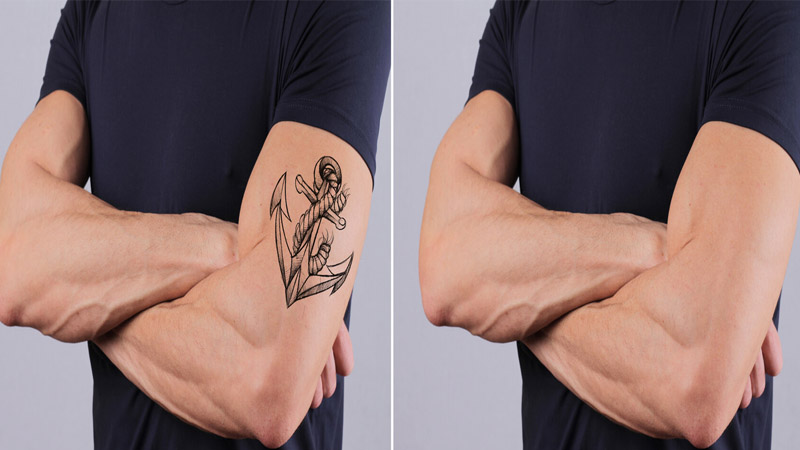The Truth About Getting Your Tattoos Removed

For the moment you start regretting your old ink.
Before you get a tattoo you’re usually swarmed by friends and family making sure you’re 100% sure about your design. It’s better safe than sorry when it comes to permanent ink on your body. They’re not just being annoying: A recent survey by Advanced Dermatology found that 78 percent of the 600 participants said they regret at least one of their tattoos.
And if you find yourself in that camp—whether you find that you’ve outgrown the tattoo you got when you were younger or you’re just not impressed with how the art turned out—tattoo removal is an option. No, tattoo removals don’t completely erase the past, but they’ll make your old ink look far less noticeable and are perfect for those hoping to get a cover tattoo later on.
Removing a tattoo is a complicated process and there are a lot of aspects to consider. And you’re not alone if you have a bunch of questions. So, here’s everything you should know before taking the steps to say goodbye to your ink.
How can I remove my tattoo?
There are a number of methods to achieve a tattoo removal, including dermabrasion, chemical peels, and surgical excisions. These options are often pretty aggressive and pretty invasive. This is why the most common and effective method is by laser treatment.
A high-intensity laser is used to break up the ink particles of the tattoo into smaller pieces that can then be naturally removed by the immune system. Although different lasers are necessary for different colors, the American Society for Dermatologic Surgery explains that a Q-Switched laser is typically used in order to remove the tattoo without causing damage to surrounding tissue. That’s important, as that ultimately decreases scarring.
“Tattoo removal is something where people really need to seek out the right treatment and usually that’s with a slow, methodical treatment approach in a dermatology office using either a Q-switched laser or pico-type wavelengths,” said Joel Cohen, MD, associate clinical professor of dermatology at the University of California at Irvine.
And that slow approach means your tattoo isn’t going to just disappear overnight. The process is pretty lengthy with multiple laser treatment sessions required to accomplish complete removal. Although it depends on the design, size, and color of your ink, laser tattoo removal can take 1 to 10 sessions, with 6-week healing periods in between sessions.
Do tattoo removals hurt?
Long story short, yes. Tattoo removals can be painful but are tolerable. They will most likely be more painful than the tattoo process but hey, you survived that. Doctors suggest taking non-aspirin products such as acetaminophen/Tylenol prior to the procedure to reduce the pain. But if your pain tolerance is lacking or you’re simply nervous about the process, many doctors offer other pain management options such as numbing creams, skin cooling devices, and in some cases an injection of a local anesthetic.
How much do tattoo removals cost?
The price of a laser tattoo removal is often based on the size, location, and intricacy of the tattoo design. But you can definitely expect to pay much more than you paid to get the tattoo done in the first place. The American Society for Aesthetic Plastic Surgery estimates the average laser removal can cost $463 per session.
“In the best case scenario, the tattoo can be completely removed in five sessions or less,” said New York City-based dermatologist Arash Akhavan, MD. “Unfortunately, some cases can be more stubborn and more than 20 treatments may be needed.”
And because tattoo removals are a cosmetic procedure, they’re likely not covered by insurance.
Are tattoo removals safe?
Yes, if you find the right doctor. Using a certified laser professional lowers the possibility for side effects.
“There is an art to tattoo removal, and we see, unfortunately, a lot of patients with bad outcomes who go to non-medical facilities or even hair salons,” said Cohen. “People really want to look for the right equipment or right office.”
But of course, with all procedures there is still the possibility for side effects including:
- Hyperpigmentation
- Hypopigmentation–which is more common for those with darker skin tones
- Infection
- Scarring
- Lack of complete pigment removal
Aftercare is super important in helping to protect you from these. You can expect minor swelling, redness, and tenderness after the tattoo removal process. Although each doctor will provide you with their own specific instructions for at-home care, most professionals will suggest these tips: Avoid picking any scabs or blisters that form during the healing process to avoid scarring, avoid tight clothing or exposure to direct sunlight, and keep the area clean and covered with an antibiotic healing ointment and bandage. Many of the aftercare instructions will be similar to those taken when you initially got the tattoo done.




